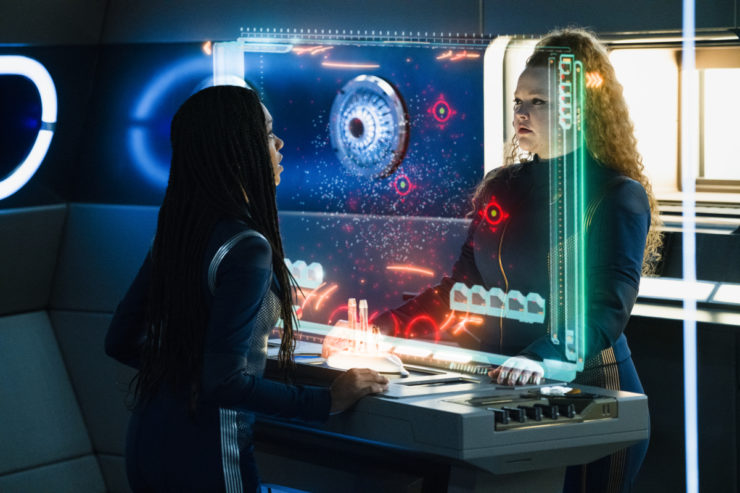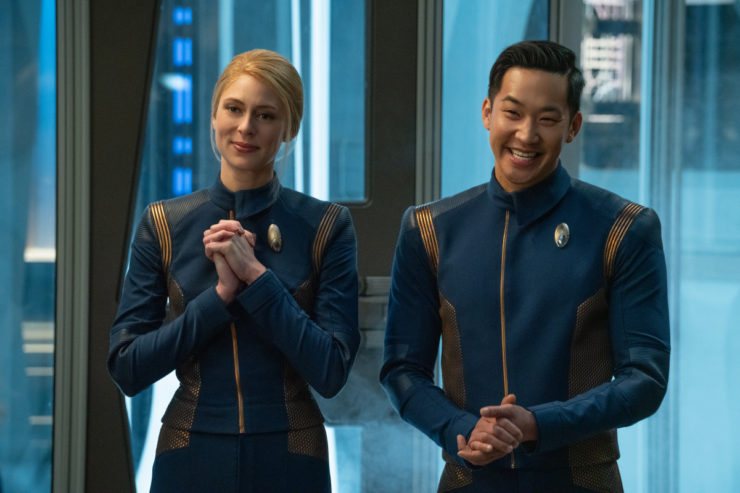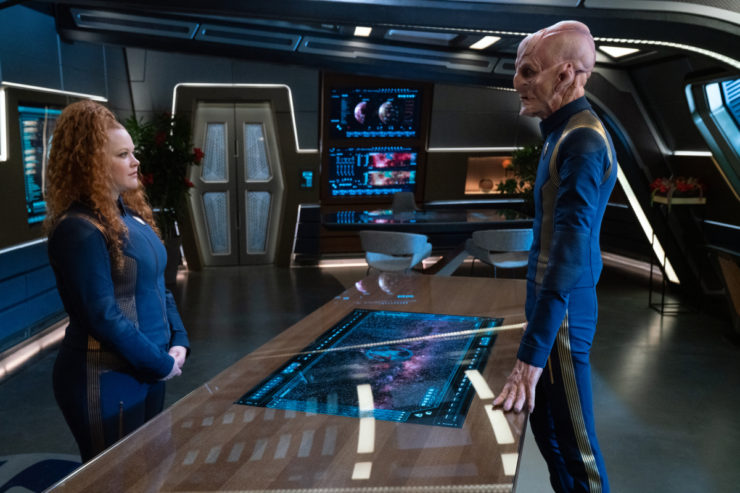I suspect that the events of this latest episode of Discovery are going to prompt a lot of discussion amongst Trek fans. There are two plots going on here. There’s an A-plot that picks up threads from season two of Discovery and season one of Picard, along with the title-implied references to the arc Spock went on starting in TNG‘s “Unification” two-parter through to the 2009 movie. And then a B-plot about the new acting first officer on Discovery.
Let’s start with the B-plot, ’cause that’s the bit that’ll be more contentious. With Burnham’s demotion last week, Saru needs a new acting first officer to run the day-to-day of the ship until a more permanent Number One can be assigned.
Saru’s surprising choice is Tilly.
Buy the Book


Remote Control
This choice will, I’m sure, blow up the Internet, so let me start lighting the match here. In the abstract, this is a terrible choice, for reasons Tilly herself lays out to Saru: She’s only an ensign. She had just barely started her training on the command track last season, and will now never really finish it. There are several higher ranking, better qualified people to be second-in-command of the ship, and on the fact of it, this makes about as much sense as Cadet Kirk being suddenly made first officer in the 2009 Star Trek.
But I’m actually okay with this choice for two reasons, one in-universe, one out-of-universe.
If Discovery weren’t timelost, this would be insane. But if that were the case, new officers would be a dime a dozen and ready to jump in. However, Discovery isn’t in the 23rd century anymore, and they’re still strangers in a strange land. On top of that, Tilly has been the heart and soul of this crew, the moral center, the geekiest geek in a ship full of geeks. In a lot of ways, she’s the perfect person to run the day-to-day of this particular ship and this particular crew.
On top of that, I watched this episode while sitting on the couch with my wife, who, when Tilly was offered the position, and especially when the entire senior staff told her to say yes to it, was bouncing up and down on the couch and squeeing.
I’ve been with Wrenn for eleven years. This is the first time I’ve seen a TV show make her both bounce and squee.
And the reason why is because Tilly is her favorite character. Wrenn loves Tilly because she sees herself in the ensign: a plus-sized redhead who tends to talk to much, who doesn’t hide how smart she is, and who has often been slapped down by family for being too talkative and too smart. It is vanishingly rare for dramatic fiction to even acknowledge that plus-sized awkward smart women exist, and on those oh-so-few occasions, the character in question is almost always comic relief. And if you think this is an esoteric or tiny percentage of the population, then I question whether or not you’ve actually paid attention to the world, because trust me, such women are everywhere, and they’re often told to keep their mouths shut, told that their body type is not acceptable, and they shouldn’t act so publicly smart.
Tilly is a hero to my wife and a hero to these women, and I have absolutely no problem, none, with seeing her rewarded for it.
As for the A-plot, I suspect there will fewer issues there, because writer Kirsten Beyer (who, full disclosure, is a friend of your humble reviewer) beautifully weaves together threads from Trek‘s 23rd- and 24th-century past into a compelling 32nd-century storyline.

Burnham has been afraid to read up on Spock’s past since gaining access to Starfleet records, but now she learns that he spent the last decade or so of his life on a long-term mission to reunite the Vulcan and Romulan people. (In a nice touch, Saru and Burnham—who are from a time before it was commonly known that Romulans are a Vulcan offshoot, as that didn’t become public until the original series’ “Balance of Terror,” which took place eight years after Discovery popped into the future—are completely gobsmacked by this.)
And, as Spock himself predicted in “Unification II” to Picard—a declaration that Burnham encounters in the logs of Admiral Jean-Luc Picard, to whom Spock said those words—it would probably take decades, if not centuries, for his efforts to bear fruit. But by the 32nd century, they have done so. The planet Vulcan has been renamed Ni’Var, and Vulcans and Romulans share the world.
Things are not in perfect harmony, though, as the peace between the Vulcans and Romulans is tenuous. On top of that is another revelation that stuns Saru and Burnham: Ni’Var is no longer part of the Federation. At least part of why they aren’t relates to SB-19, a project that has data regarding the Burn, but which also—so Ni’Var claims—establishes that SB-19 caused the Burn.
The problem is that Burnham and Tilly have triangulated the three black boxes they do have. It’s not enough to pinpoint the Burn’s center precisely, but they are quite certain that it’s nowhere near The Planet Formerly Known As Vulcan. And so Discovery travels to Ni’Var because they have the one thing that might get the Vulcans and Romulans to talk to the Federation again: Ambassador Spock’s long-lost sister.
There are so many fantastic moments in this episode, but my absolute favorite is when Burnham watches the footage of Spock talking to Picard from “Unification II” and seeing the huge grin of sibling pride on her face. Knowing that her brother lived a long and fruitful life, culminating in a batshit crazy long-term mission that he knew he wouldn’t live to see fulfilled fills her with a nearly incandescent joy, and it’s so delightful to see.

Burnham is also able to use her knowledge of Vulcan traditions, having been raised with them, to invoke the T’Kal-in-ket. This is so perfectly Vulcan, a ritual from Surak’s time that has the same trappings as the other ancient Vulcan rituals we’ve seen, but one specifically designed to air scientific arguments before a council of three.
Best of all is that the 32nd-century version has adapted to the new Vulcan-Romulan unification by having the speaker to the council have an advocate who comes from the Qowat Milat. One of many nifty aspects of Romulan culture that was established in the first season of Picard (which was co-created by Beyer), the Qowat Milat is an order of women who are dedicated to absolute candor and who pledge themselves to lost causes.
That isn’t even the best part, because Burnham’s relationship with Spock isn’t the only callback to season two of Discovery: The Qowat Milat sent to be Burnham’s advocate is none other than Gabrielle Burnham. Yes, we finally find out what happened to Burnham’s Mom when she went back to the future in “Perpetual Infinity.”
It’s never a bad thing to see Sonja Sohn in anything, and she once again is superb as Gabrielle. She magnificently fulfills her role as advocate, as Qowat Milat, and as Michael’s mother, primarily by getting Burnham to admit that she’s flawed and conflicted and having trouble adjusting to life in the future. This has two benefits: It gets Burnham to realize that Discovery is where she belongs despite the issues she’s had readjusting to life aboard ship over the past several episodes, and it impresses President T’Rina enough that she provides the SB-19 data after initially refusing.
Not that T’Rina’s initial refusal wasn’t warranted. As seen in the squabbling among the three members of the council (played perfectly by Oliver Becker with passion, Stephanie Belding with caution, and Emmanuel Kabongo with spectacularly snotty arrogance), Ni’Var’s peace and harmony is tenuous at best. As T’Rina herself says, Burnham’s inquiry risks tearing open old wounds that have barely healed.
I really hope we see more of Ni’Var, mostly because I want to see more of T’Rina, played with amazing gravitas by Tara Rosling. Her conversations with Saru stand out as brilliant in an episode that’s already full of great conversations, as captain and president make a connection that bespeaks future mending of fences between the Federation and Ni’Var. More than the spore drive, more than a crew that was willing to sacrifice everything to save the galaxy, more than the brilliance of Tilly, Reno, Stamets, and the rest, more than Detmer’s superlative piloting skills, Discovery‘s greatest asset is Saru. He embodies everything that is best about the Federation in a two-meter-tall, really skinny form. His superlative work here with T’Rina is the heart and soul of an episode that is already overstuffed with both those things.
This may be the best episode of Discovery yet, a brilliant extrapolation of the future built on a foundation of what was established in the past.
Keith R.A. DeCandido‘s next novel is Animal, a thriller he wrote with Dr. Munish K. Batra, about a serial killer who targets people who harm animals. It’s now available for preorder, and if you preorder it directly from WordFire Press, you get a free urban fantasy short story by Keith.










